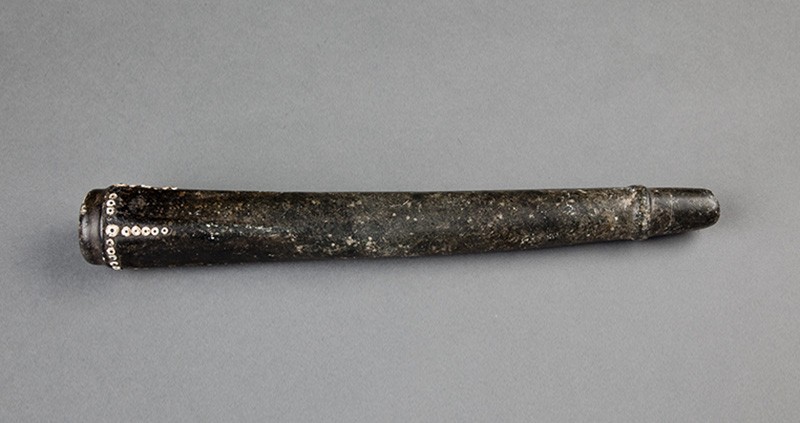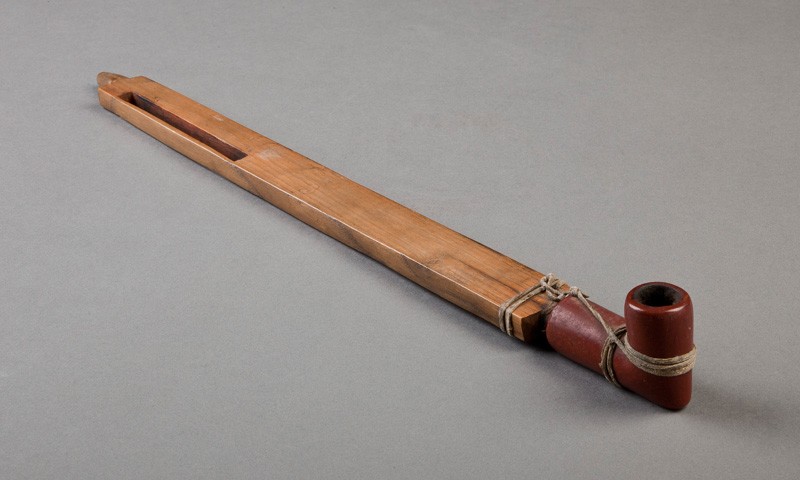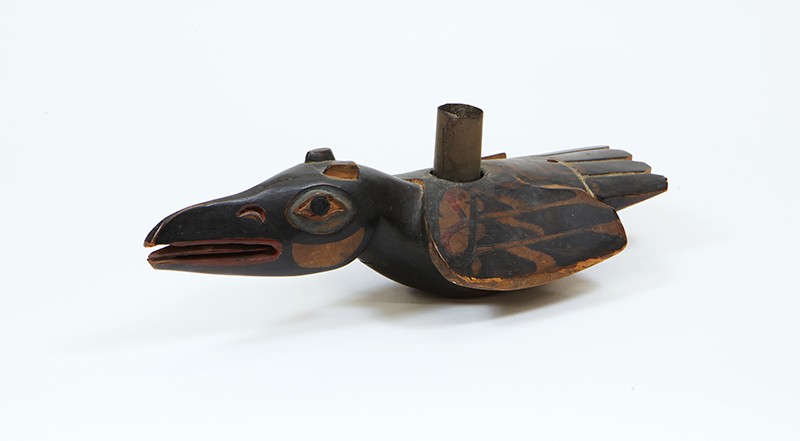2002 North Main Street
Santa Ana, California 92706
TEL: 714.567.3600
Father’s Day Pipe Dream
 |
| Pipe, 1000-1700 Chumash culture; California Steatite and clam shell beads; 1 9/16 x 1 x 12 3/16 in. 80017 Fred Randolph Aldrich Collection |
This is a Pipe
Does the apotheotic father smoke a pipe? Perhaps he has not since at least the 1950s. Still though, a dad casually puffing on a pipe—maybe on a Sunday morning while reading the paper, fooling around with a model train, or mentally preparing for an afternoon of struggling with a home brew kit—is a notion which is burned in the collective consciousness of many, independent of whether our own fathers were partial to said casual puffing or not. In this Father’s Day post we honor this fatherly activity by looking at how pipes were made and used in three different Native American traditions, two of which are currently on view in First Americans: Tribal Art from North America.
Steatite Smokers
We begin just off our Southern Californian coast on the small island of Santa Catalina. Archeological evidence here indicates that people have inhabited the island some 8000 years, long before it became a hotspot for weekend bison enthusiasts. Closely related to the Gabrielino-Tongva of the mainland, Catalina’s later pre-contact residents were commonly referred to as Cataliños. The mainstay of the island was its soapstone (or steatite), quarried in several locations centered around the site of the modern-day airport. From this easily-worked stone, the island’s material culture was carved. Bowls, pendants, charmstones, and pipes, the subject of this post were all carved from the easily workable rock. This work was essential to the islanders who needed to trade for many of the items which could not be procured on their small island. The result was that the works became part of an extensive trading network which sprawled across the southern Californian coast, often exchanged for pelts or harder stones such as obsidian which found better use as a tool than as a workable medium. All of this is to explain how the Chumash living far to the north of Catalina would have obtained a soapstone pipe. Like this pipe, many Chumash objects were decorated with small clam shell beads. Often times these beads lent features to zoomorphic forms—the eyes or mouth of a whale, as an example—here we see that it simply functions as a geometric design.
 |
| Pipe, c. 1870 Cheyenne people; North America Ash wood, leather, cotton cloth and catlinite; 1 3/4 x 16 x 1 1/4 in. 33120 Gift of Mr. Lawerence Gale |
A Plain Pipe
Catlinite is a reddish-brown stone found primarily in Minnesota quarries. It was so commonly used in the pipe bowls of Great Plains Native American groups that it became colloquially known as pipestone, something which this pipe’s angular red-stone bowl itself evidences. Much like steatite, catlinite was easy to carve with just a knife making it an ideal material to work with. This ease allowed for intricate carvings to be worked into the red stone. Other examples in the Bowers Collections do a better job of evidencing the complex designs Plains groups carved from catlinite, but most of these later works were made for trade. Traditionally these pipes, so often reduced to the misnomer “peace pipes,” were used in an array of ceremonies and prayers. Sealing compacts, including those which came at the end of wars was only one such use. Tobacco itself held a complicated relationship with many of the deities of Plains groups. Its smoke served as a summoning call, and its effect on the individual elevated one on a spiritual plane.
 |
| Ceremonial Pipe, early 20th Century Tlingit culture; Northwest Coast Region, North America Wood, paint and metal; 4 1/4 × 5 7/8 × 13 1/2 in. 2016.14.7 Gift of the Herbert W. Clark Trust |
The Reliability of Images
Unlike many Native American groups, the Tlingit only began smoking tobacco after their first contact with Russian explorers in 1741. When it came to creating pipes of their own, the Tlingit used the same curvilinear framework which gave their art its signature stylistic consistency: formlines. The thick, curving geometric shapes which we see constituting this pipe’s Raven—an incidental Prometheus figure in Tlingit tradition—are very much the result of these formlines. The truly curious note regarding many Tlingit pipes is their medium. Unlike the stone of Californian and Plains groups, the Tlingit often crafted pipes from gun parts. Wooden stocks would be carved and painted to become the body of the pipe and the bowl itself would be made from either reworked barrels or shell casings. This pipe is deceptively large, too wide in any dimension to have been worked from a gun. A narrow hole at the base of the bowl connects to another at the rear of the pipe from which a stem would likely have been inserted. The variety of tobacco used for smoking was not grown locally and had to be traded for. It was smoked exclusively by men as a means of communing with the spirit world.
Text and images may be under copyright. Please contact Collection Department for permission to use. References are available on request. Information subject to change upon further research.

Comments